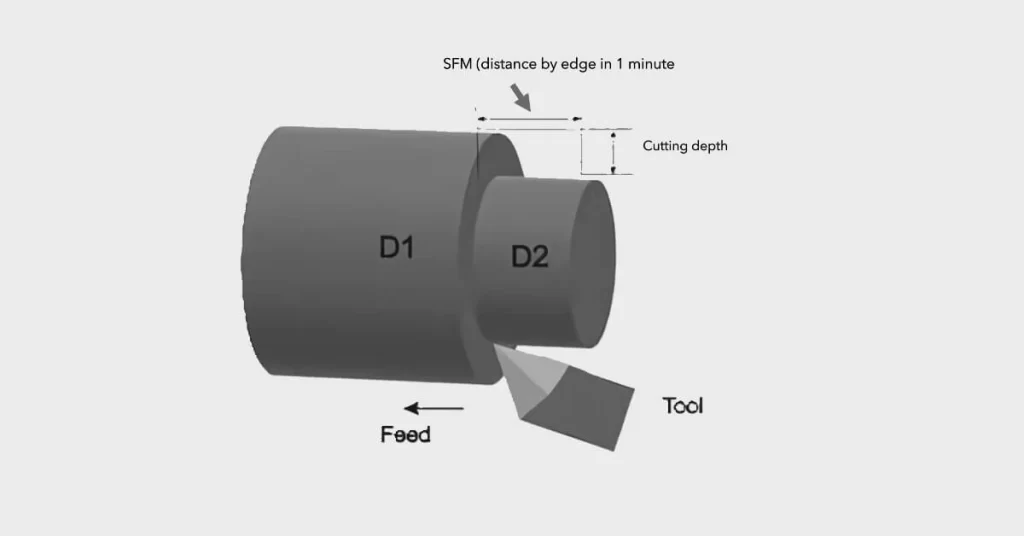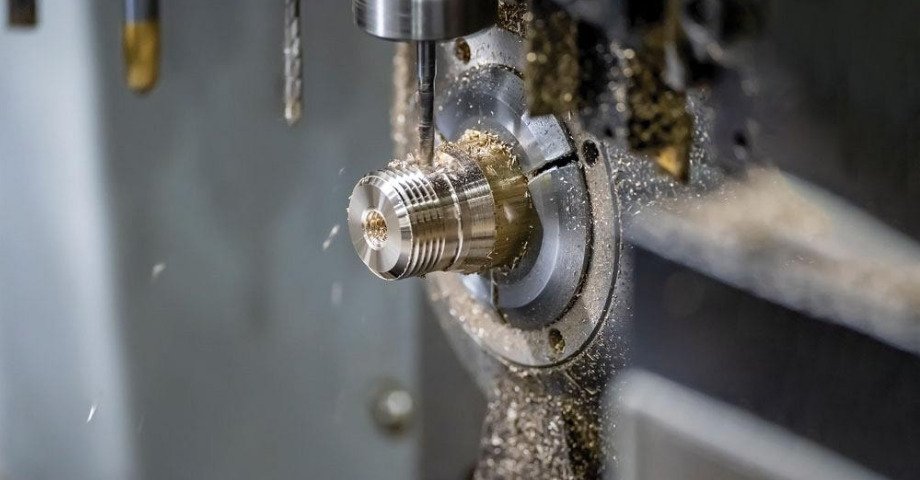Dans le monde de précision de Usinage CNC, chaque variable compte. Parmi ceux-ci, Pieds de surface par minute (SFM) joue un rôle crucial pour garantir l’efficacité, précision, et longévité de l'outil et de la pièce. Si vous êtes fraisage, forage, tournant, ou affûtage, comprendre et appliquer correctement la GDF est essentiel pour des performances optimales.
Ce guide détaillé détaille tout ce que vous devez savoir sur la GDF : de quoi s'agit-il ?, Comment ça fonctionne, comment le calculer, et comment cela affecte vos résultats d'usinage.
Qu'est-ce que la GDF (Pieds de surface par minute)?
Pieds de surface par minute (SFM) fait référence au vitesse linéaire auquel un outil de coupe se déplace sur la surface de la pièce à usiner. Contrairement à Tours par minute (RPM), qui vous indique uniquement la vitesse de rotation de l'outil ou de la broche, SFM mesure la vitesse à laquelle le tranchant se déplace réellement à travers le matériau..
🔍 Pourquoi c'est important:
La GDF est dépendant du matériau—vous avez besoin de différents paramètres SFM pour l'aluminium, acier, plastiques, etc..
Cela affecte directement usure des outils, temps d'usinage, génération de chaleur, et état de surface.
Unité de mesure: SFM est généralement exprimé en pieds par minute (pieds/min).
Quel est l'impact de SFM sur les processus d'usinage?
🧱 1. Il contrôle la vitesse à laquelle vous pouvez couper
Lorsque vous définissez la bonne vitesse de surface, votre outil se déplace sur le matériau au bon rythme.
Trop rapide? Vous allez brûler l'outil.
Trop lentement? Vous perdez du temps et risquez d'avoir une finition difficile.
Le sweet spot aide à éliminer rapidement la matière sans stresser votre machine ou votre outil.
🧰 2. Cela aide vos outils à durer plus longtemps
Personne ne veut changer d'outil toutes les quelques minutes, droite?
Un bon SFM garde les choses au frais et sous contrôle.moins de chaleur = durée de vie de l'outil plus longue. Un SFM élevé peut rendre l'outil émoussé plus rapidement, surtout sur les métaux durs. Mais avec le bon réglage, vos outils restent affûtés et vos travaux restent sur la bonne voie.
✨ 3. Cela affecte la finition de la surface
Vous voulez une pièce qui semble lisse au toucher? Alors votre vitesse de surface compte.
Si tu pars trop vite, la pièce pourrait surchauffer, s'étendre légèrement, ou obtenir une surface brûlée.
Si tu pars trop lentement, l'outil peut frotter au lieu de couper, laissant derrière lui une finition rugueuse ou inégale.
Le bon SFM vous offre cela faire le ménage, brillant, surface professionnelle-pas de ponçage nécessaire.
🔥 4. Il contrôle l’accumulation de chaleur
L'usinage crée toujours de la chaleur, mais trop de choses provoquent des problèmes comme:
Dommages à l'outil
Pièces déformées
Les copeaux collent au lieu de s'effacer
En choisissant le bon SFM et en utilisant du liquide de refroidissement si nécessaire, vous pouvez gérer la chaleur et éviter les problèmes thermiques avant qu'ils ne commencent.
Applications du SFM dans les processus d'usinage
🧰 Fraisage
Le fraisage utilise des outils rotatifs pour enlever de la matière. La valeur SFM influence la vitesse à laquelle vous pouvez couper. Un GDF plus élevé (avec une avance appropriée) améliore l'efficacité et la finition de surface.
🌀 Forage
Perçage dans des matériaux durs (par exemple., acier) nécessite un SFM soigneusement contrôlé pour éviter la surchauffe et l'usure du foret. Une vitesse correcte empêche également le désalignement des trous et le brunissage.
🔁 Tournant
Dans les opérations de tournage, SFM détermine la vitesse à laquelle la pièce rotative engage l'outil de coupe stationnaire. Trop rapide provoque une surchauffe; trop lent conduit à des coupes grossières.
⚙️ Broyage
Pour rectification cylindrique ou plane, la vitesse de la meule (mesuré en SFM) affecte à la fois la finition et la durée de vie de la roue. Une GDF appropriée garantit l’efficacité, coupes nettes et empêche le vitrage des roues.
Comment calculer le SFM en usinage
Le formule pour calculer SFM est:
SFM=π×D×RPM12text{SFM} = frac{\pi fois D fois RPM}{12}
Où:
D = Diamètre de l'outil ou de la pièce (en pouces)
RPM = Tours par minute
12 = Convertit les pouces par minute en pieds par minute
📌 Exemple:
Si vous utilisez une fraise en bout de 3 pouces de diamètre à 900 RPM:
SFM=3,1416×3×90012=706,86 pi/mintexte{SFM} = frac{3.1416 \fois 3 \fois 900}{12} = 706.86 \, \texte{pieds/min}
Outils et logiciels pour le calcul SFM
Pour gagner du temps et réduire les erreurs, les machinistes utilisent des outils et des logiciels spécialisés:
🛠 Outils:
Calculatrice du machiniste – Idéal pour les conversions en atelier et les calculs d’avance/vitesse.
Calculateurs GDF en ligne – Gratuit et accessible depuis n’importe quel navigateur.
Panneaux de commande de machines CNC – Souvent livrés avec des calculatrices intégrées.
Logiciel CAM – Intègre les calculs SFM avec les parcours d'outils.
🧠 Logiciel recommandé:
G-Assistant – Calculateur de vitesse/avance avec base de données de matériaux/outils intégrée.
Assistant FS – Calculateur de vitesses en temps réel, aliments, et GDF.
Conseiller HSMA – Outil avancé pour équilibrer SFM, taux d'avance, et profondeurs de coupe.
Calculatrice du machiniste Pro – Version d'application avec des capacités de calcul robustes.
Effets d'un GDF trop élevé ou trop faible
🔺 SFM trop élevé – Quand vous coupez trop vite
Aller trop vite peut sembler une bonne chose : faites le travail plus rapidement, droite? Mais en usinage, plus vite n'est pas toujours mieux.
Voici ce qui peut mal se passer:
🔥 1. Surchauffe
Quand le tranchant bouge trop vite, cela crée une tonne de friction et de chaleur. Cette chaleur s'accumule rapidement, et si votre liquide de refroidissement ne peut pas suivre, votre outil peut commencer à griller.
💥 2. Usure et casse des outils
Un SFM élevé fait que les bords de votre outil s'émousser plus vite. Dans certains cas, ça peut même puce ou bouton-pression votre outil de coupe si le matériau est suffisamment résistant.
✨ 3. Mauvaise finition de surface
L'excès de chaleur ou de vibrations provoqué par des vitesses élevées peut vous laisser une sensation de rugosité., incompatible, ou même surface brûlée- ce n'est pas un bon look pour une pièce usinée.
💸 4. Coûts plus élevés
Plus d'outils cassés = plus de remplacements = plus d'argent de votre poche.
🔻 SFM trop faible – Lorsque vous coupez trop lentement
Jouer la sécurité et aller trop lentement peut sembler une décision judicieuse, mais ça peut aussi se retourner contre moi.
🧊 1. Frotter au lieu de couper
Si l'outil bouge trop lentement, il risque de ne pas « trancher » le matériau correctement. Plutôt, c'est juste se frotte contre lui, accumuler de la chaleur et user votre outil sans vraiment couper beaucoup.
⌛ 2. Production plus lente
Des vitesses inférieures signifient des temps de cycle plus longs. Si vous usinez des centaines de pièces, ça s'additionne vite.
🧱 3. Mauvaise finition
Les vitesses lentes provoquent souvent bavarder, vibration, et bords plus rugueux-pas la finition lisse que vous souhaitez.
🌡️ 4. Accumulation de chaleur (Oui, Même quand lent!)
Étonnamment, aller trop lentement peut quand même générer de la chaleur, mais d'une manière différente. Au lieu de trancher proprement, l'outil se débat et frotte, ce qui crée de toute façon des frictions et de la chaleur.
Paramètres SFM recommandés pour les matériaux courants
| Matériel | Outils HSS (SFM) | Outils en carbure (SFM) |
| Aluminium | 250–400 | 600–1000 |
| Laiton | 300–600 | 800–1200 |
| Fonte | 60–120 | 400–800 |
| Acier doux | 70–150 | 300–600 |
| Inconel | 10–30 | 50–200 |
| Cuivre | 100–300 | 500–1000 |
| Plastique | 300–800 | 800–2000 |
| Titane | 30–70 | 100–300 |
Note: Utilisez des outils revêtus et du liquide de refroidissement pour les matériaux durs.
Facteurs qui influencent la sélection de la GDF
🔧 Type d'opération
Différents processus exigent des vitesses différentes. Le fraisage peut permettre un SFM plus élevé que le perçage ou le tournage, en fonction de l'engagement de la fraise.
🪚 Matériel d'outil
HSS: Capacité GDF économique mais inférieure
Carbure: Résiste à des vitesses plus élevées
Céramique / Cbn: Pour conditions extrêmes
🔩 Matériau de la pièce
Les matériaux plus durs nécessitent un SFM inférieur pour réduire la chaleur et la friction.
🏭 Capacités des machines
Les limites de régime et la rigidité de votre machine CNC affectent le SFM que vous pouvez réaliser sans provoquer de vibrations ou d'instabilité..
💦 Liquide de refroidissement & Lubrification
Le liquide de refroidissement réduit la chaleur et améliore la finition de surface, permettant un SFM légèrement plus élevé en toute sécurité.
Conclusion
SFM n'est pas qu'un chiffre : c'est un élément essentiel de votre stratégie d'usinage.. Que vous exécutiez un prototype rapide ou un travail de production complet, obtenir le bonne vitesse de surface peut faire la différence entre le succès et des retouches coûteuses.
À Précision au sommet, nous utilisons des logiciels avancés et des connaissances expertes pour affiner le SFM et tous les autres paramètres pour un usinage CNC de précision. Laissez-nous vous aider à optimiser la performance de votre prochain projet, coût, et la qualité.






